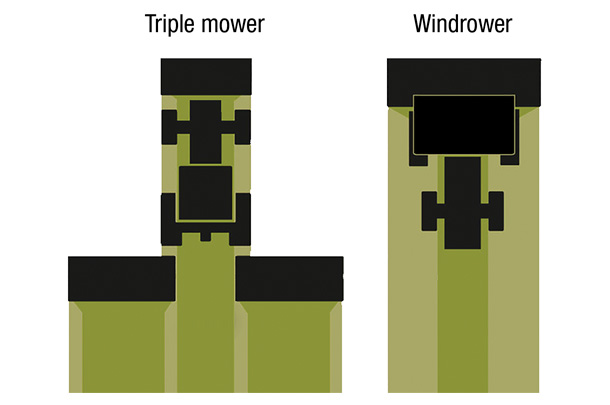The timing, technique and tools used all positively or negatively affect the outcome of an entire season’s worth of work. My question for producers is this: Are you getting the most out of your forage crop? Consider how your timing, technique and tools impact your forage crop and bottom line.
Timing is key
Forage harvesting is a process that takes days, not hours. It requires long weather windows and just the right timing to retain peak nutritional value. Long-time forage agronomist Dr. Dan Undersander says the key to quality forage begins with a quick drydown. The cut forage crop continues to lose nutritional value as it matures through plant respiration until it dries to 60% moisture. The quicker you can get moisture down to that level, the more nutritional value is retained. The two most crucial factors when it comes to timing are: how fast crop moisture drops below 60% and how fast the hay is ready for baling or chopping.
Consider your technique
The lower the cut, the more likely you are to have soil mixed into your forage. Increasing cutting height will result in decreased yield; however, it will reduce ash content and improve forage quality. Where is the sweet spot? We recommend 2.5 to 3 inches for alfalfa and 3 to 4 inches for grass to balance yield trade-off with potential ash inclusion.
Additionally, a wide swath after cutting is the most important factor for maximizing initial drying rate and preserving starches and sugars. Studies conducted by Undersander suggest that higher crop relative feed quality (RFQ) (starch and sugar) can be attributed to a wider windrow width. He recommends laying the crop in the widest windrow possible, with more than 70% cut width as good and greater than 90% as optimal.
Reduce ash content
When improving the quality and value of forage, ash content should remain top of mind. The total ash content of a producer’s forage can play a critical role in animal performance. In addition to greater wear on harvesting equipment, ash can lower forage intake, reduce digestibility, negatively affect fermentation and dilute the forage’s nutritional value. When a crop contains excess ash, milk production or feed-to-gain decrease because a ruminant can only consume so many pounds of feed per day based on the feed’s rate of digestibility. Poor-quality forage will simply take up space in a cow’s stomach, not delivering nutritional value and making it impossible to increase milk production or feed-to-gain.
Work smarter with a triple mower
Forage quality is the key advantage of operating a triple mower versus self-propelled windrower. To produce the exceptionally wide windrows needed for quick drydown, a triple mower is the best tool of choice. On the contrary, self-propelled windrowers cut the crop in front of the machine and narrow the swath so the machine wheels don’t run over the cut crop. The wider the cutter bar, the more the total width is narrowed to pass cleanly underneath the machine. This design requires tight, narrow windrows, leading to a longer drydown period and lost nutritional value.
 Comparatively, triple mowers have two more mowing units and the added flexibility of using the tractor for other tasks outside of the mowing season. Triple mowers consist of a front mower just wider than the edges of the tires of the tractor and two wing mowers in the back. Because the wing mowers are operating behind the machine, there is no need to compress the windrow. The resulting swaths are greater than 90% of the cut width and often twice the width of crop mowed with a self-propelled windrower.
Comparatively, triple mowers have two more mowing units and the added flexibility of using the tractor for other tasks outside of the mowing season. Triple mowers consist of a front mower just wider than the edges of the tires of the tractor and two wing mowers in the back. Because the wing mowers are operating behind the machine, there is no need to compress the windrow. The resulting swaths are greater than 90% of the cut width and often twice the width of crop mowed with a self-propelled windrower.
There are two aspects of the wide swath that are significant, according to Undersander. The first is: Sunlight is the most important factor for drying. For example, if you spread the swath out and cover 100% of the field, you’re using all the available sunlight. If you put it in a windrow, covering a third of the field, you’re preventing the sunlight from reaching two-thirds of the crop. So a wide swath intercepts more sunlight and dries quickly. The second aspect is the density of the layer. When we spread out the crop, we have a less dense crop mat. If we put the crop in one big windrow, that windrow insulates itself, and it doesn’t dry as well. No matter what kind of mower used on your operation (pull-type, front or rear-mounted, or triple mower), it should maximize swath width relative to cutting width.
Forage crops are a critical part of every successful operation. A seasoned producer knows that forage quality can make a dramatic difference in animal performance and health. The yield of milk and meat cattle produce is dependent on the nutrients consumed, which makes forage quality a key factor of the diet. For better forage quality, consider your timing and technique, set your equipment to reduce ash content and work smarter with a triple mower. At the end of the day, high-quality forage means a healthy herd and a better bottom line.











